Guerrilla Girls set to rattle some cages at Rauschenberg Gallery in January
 Florida SouthWestern State College will be presenting GUERRILLA GIRLS: Rattling Cages Since 1985 from January 17 through March 23. Sited in the Bob Rauschenber Gallery, the exhibition will be a site-specific survey and newly-commissioned, interactive installation.
Florida SouthWestern State College will be presenting GUERRILLA GIRLS: Rattling Cages Since 1985 from January 17 through March 23. Sited in the Bob Rauschenber Gallery, the exhibition will be a site-specific survey and newly-commissioned, interactive installation.
The Guerrilla Girls is an internationally-renowned feminist advocacy and art collective which assiduously maintains its anonymity while confronting and addressing systemic problems of gender and racial parity in the art world.
Since 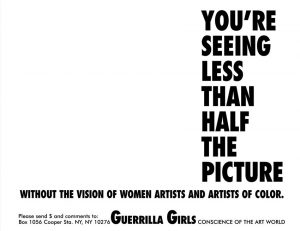 their formation in 1985, the Guerrilla Girls have done more than 100 street projects, posters and stickers in cities ranging from New York, Los Angeles and Minneapolis to Mexico City, Istanbul, London, Bilbao, Rotterdam and Shanghai. They have also done outrageous projects and exhibitions at museums, attacking them for their bad behavior and discriminatory practices right on their own walls. Of these, their stealth project on the façade of the Whitney Museum in
their formation in 1985, the Guerrilla Girls have done more than 100 street projects, posters and stickers in cities ranging from New York, Los Angeles and Minneapolis to Mexico City, Istanbul, London, Bilbao, Rotterdam and Shanghai. They have also done outrageous projects and exhibitions at museums, attacking them for their bad behavior and discriminatory practices right on their own walls. Of these, their stealth project on the façade of the Whitney Museum in 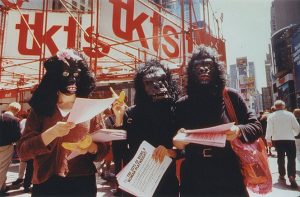 2015 stands out as a very public and publicized excoriation of income inequality and the extent to which the super-rich have hijacked art.
2015 stands out as a very public and publicized excoriation of income inequality and the extent to which the super-rich have hijacked art.
In this latter vein, the Guerrilla Girls have designed a participatory chalkboard installation for visitor “complaints” and covered the Bob Rauschenberg Gallery floor-to-ceiling with 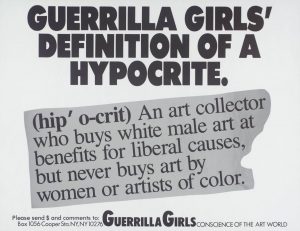 an immersive selection of the group’s most notable public art/protest poster campaigns.
an immersive selection of the group’s most notable public art/protest poster campaigns.
According to a piece in The Art Story, the Guerrilla Girls’ posters in particular were highly effective in getting their messages out. In the words of one critic, their posters “were rude; they named names and they printed statistics. They embarrassed people. In other words, they worked.”
Today, 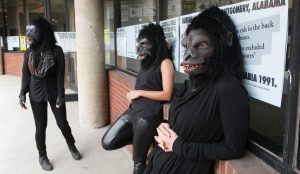 the posters are highly-valued works of art. But their oeuvre is far more expansive, consisting of billboards, performances, protests, lectures installations and limited edition prints.
the posters are highly-valued works of art. But their oeuvre is far more expansive, consisting of billboards, performances, protests, lectures installations and limited edition prints.
But who are these intrepid women?
“Our anonymity keeps the focus on the issues, and away from who 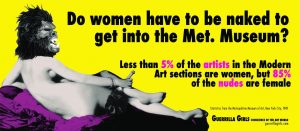 we might be,” the Guerrilla Girls point out. “We wear gorilla masks in public and use facts, humor and outrageous visuals to expose gender and ethnic bias as well as corruption in politics, art, film, and pop culture. We undermine the idea of a
we might be,” the Guerrilla Girls point out. “We wear gorilla masks in public and use facts, humor and outrageous visuals to expose gender and ethnic bias as well as corruption in politics, art, film, and pop culture. We undermine the idea of a  mainstream narrative by revealing the understory, the subtext, the overlooked, and the downright unfair. We believe in an intersectional feminism that fights discrimination and supports human rights for all people and all genders.”
mainstream narrative by revealing the understory, the subtext, the overlooked, and the downright unfair. We believe in an intersectional feminism that fights discrimination and supports human rights for all people and all genders.”
Their decision to remain anonymous operates as a poignant metaphor for the experience of women in art. At the time of the group’s formation, many art history courses taught at 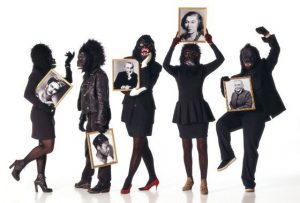 colleges and universities around the world failed to include a single female artist.
colleges and universities around the world failed to include a single female artist.
Their approach has actually served to glamorize feminism. In this regard, New York Times art critic Roberta Smith argued that the Guerrilla Girls took “feminist theory, gave it a populist twist and some Madison Avenue pizazz and set it loose in the streets.”
In 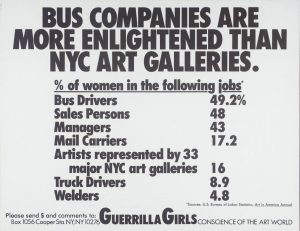 admitting only women to the group, exclusively by invitation, “the group mirrors power circles in the male-dominated art world,” adds The Art Story.
admitting only women to the group, exclusively by invitation, “the group mirrors power circles in the male-dominated art world,” adds The Art Story.
Humor is and has always been an integral part of their stratagem. Not only are the gorilla masks light-hearted and downright comic. They serve to dispel the notion that feminists have no sense of humor. But it is their wry slant of  current events and sardonic assessment on the status of women in modern society that resonates with both women and men across demographic lines. For example, they commented in a 2012 interview, “We’ve been working on a weapon, an estrogen bomb… If you drop it,
current events and sardonic assessment on the status of women in modern society that resonates with both women and men across demographic lines. For example, they commented in a 2012 interview, “We’ve been working on a weapon, an estrogen bomb… If you drop it, 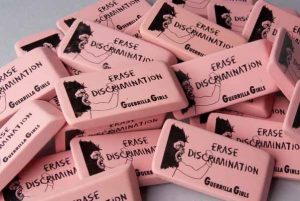 the men will drop their guns and start hugging each other. They’ll say, ‘Why don’t we clean this place up?’ In the end, we encourage people to send their extra estrogen pills to Karl Rove; he needs a little more estrogen.”
the men will drop their guns and start hugging each other. They’ll say, ‘Why don’t we clean this place up?’ In the end, we encourage people to send their extra estrogen pills to Karl Rove; he needs a little more estrogen.”
But wearing the mask is also liberating.
“Wearing this mask gives you a certain kind of freedom to say 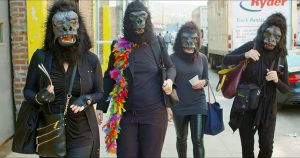 whatever you want,” adds Guerrilla Girl Frida Kahlo, who adopted the late, great Mexican artist’s name as a nom de guerre in her honor. “[If] you’re a little afraid to speak, puta mask on… You won’t believe what comes out of your mouth!”
whatever you want,” adds Guerrilla Girl Frida Kahlo, who adopted the late, great Mexican artist’s name as a nom de guerre in her honor. “[If] you’re a little afraid to speak, puta mask on… You won’t believe what comes out of your mouth!”
The 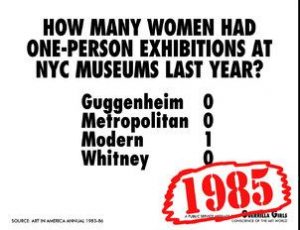 subject of recent retrospectives in Europe and a traveling U.S. museum exhibition (Guerrilla Girls: Not Ready To Make Nice) and as guests on The Late Show with Stephen Colbert, the Guerrilla Girls have been speaking up and speaking out to demand change for more than three decades. And they show no signs of letting up any time soon.
subject of recent retrospectives in Europe and a traveling U.S. museum exhibition (Guerrilla Girls: Not Ready To Make Nice) and as guests on The Late Show with Stephen Colbert, the Guerrilla Girls have been speaking up and speaking out to demand change for more than three decades. And they show no signs of letting up any time soon.
This exhibition and an adjunct billboard project have been 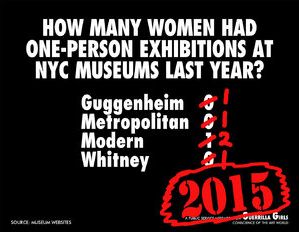 made possible by the generous support of the Diamond District and The Beaches of Fort Myers & Sanibel. For additional information please call: 239-489-9313 or visit www.RauschenbergGallery.com.
made possible by the generous support of the Diamond District and The Beaches of Fort Myers & Sanibel. For additional information please call: 239-489-9313 or visit www.RauschenbergGallery.com.
December 19, 2018.














 Tom Hall is both an amateur artist and aspiring novelist who writes art quest thrillers. He is in the final stages of completing his debut novel titled "Art Detective," a story that fictionalizes the discovery of the fabled billion-dollar Impressionist collection of Parisian art dealer Josse Bernheim-Jeune, thought by many to have perished during World War II when the collection's hiding place, Castle de Rastignac in southern France, was destroyed by the Wehrmacht in reprisal for attacks made by members of the Resistance operating in the area. A former tax attorney, Tom holds a bachelor's degree as well as both a juris doctorate and masters of laws in taxation from the University of Florida. Tom lives in Estero, Florida with his fiancee, Connie, and their four cats.
Tom Hall is both an amateur artist and aspiring novelist who writes art quest thrillers. He is in the final stages of completing his debut novel titled "Art Detective," a story that fictionalizes the discovery of the fabled billion-dollar Impressionist collection of Parisian art dealer Josse Bernheim-Jeune, thought by many to have perished during World War II when the collection's hiding place, Castle de Rastignac in southern France, was destroyed by the Wehrmacht in reprisal for attacks made by members of the Resistance operating in the area. A former tax attorney, Tom holds a bachelor's degree as well as both a juris doctorate and masters of laws in taxation from the University of Florida. Tom lives in Estero, Florida with his fiancee, Connie, and their four cats.